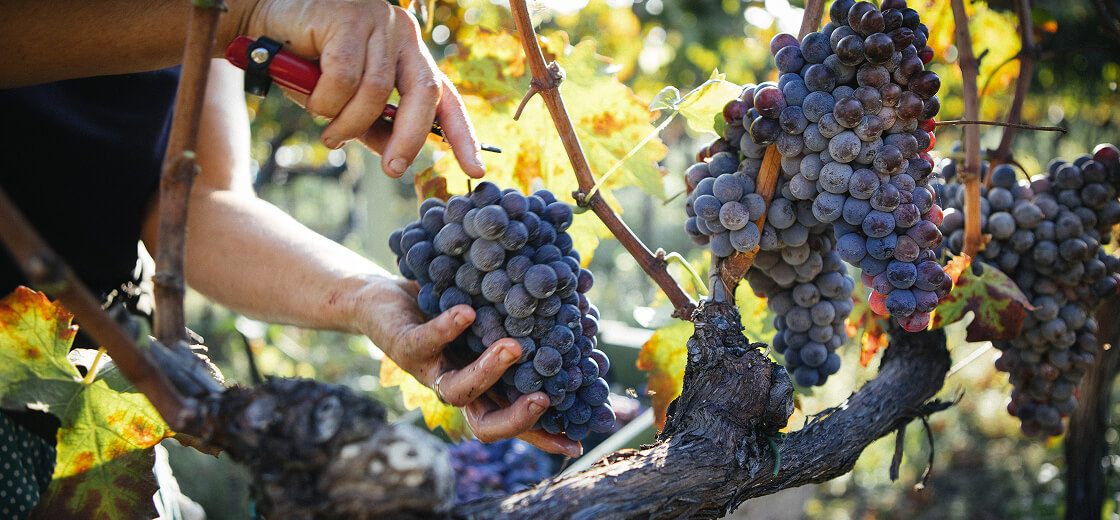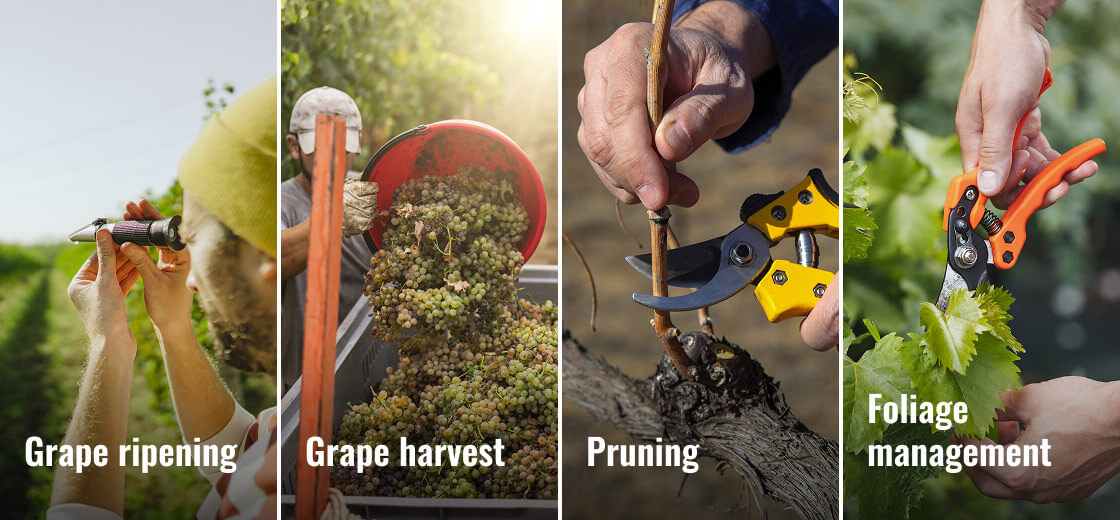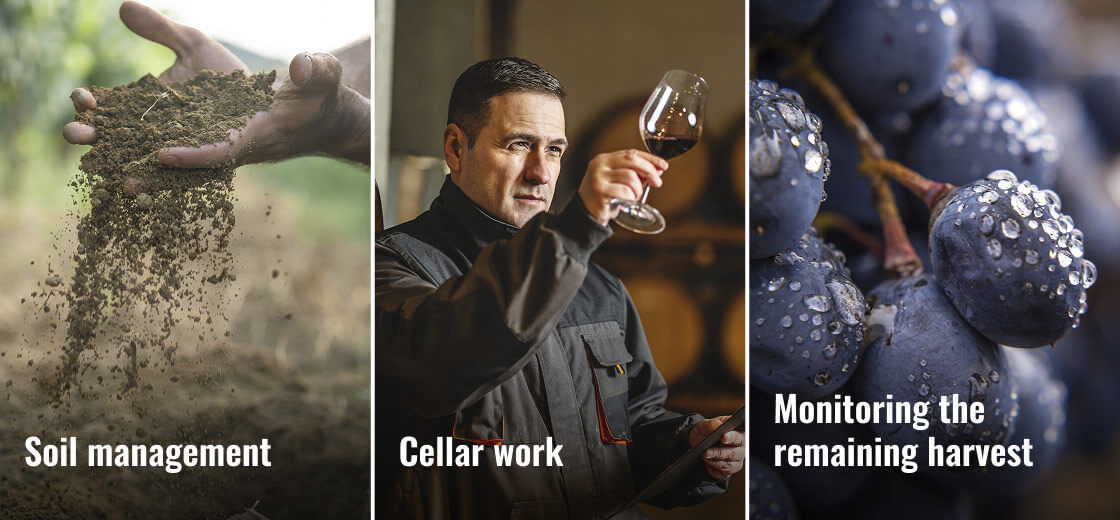Golden hours in the vineyard
When morning mist lingers over the vines and the first grapes drop into the basket, the most exciting time of the year begins for winemakers: autumn. But autumn is more than just a season – it is a decisive moment for wine. This is when it becomes clear whether the efforts of an entire year will truly bear fruit – quite literally.
The Art of the perfect moment
Yet harvesting is about far more than simply picking grapes. It’s a fine judgement: when is the perfect time? A few days too early, and the berries still carry acidity and freshness but lack aroma. A few days too late, and rain, rot or hungry birds can undo a whole year’s work. The grape harvest is a balancing act between nature and craftsmanship, experience and intuition.
Every touch leaves traces that can be tasted in the glass.
Winemakers often talk about “physiological ripeness.” By this they mean that not only are sugar and acidity in balance, but also that the aromas and tannins at the core of the berry have fully developed. And of course, the weather plays a decisive role: warm days and cool nights give the grapes the aromas that later appear in the glass as citrusy freshness, peach fragrance or mineral spice. Late rain, however, can make harvesting difficult.
Soil also has a strong influence: whether barren slate or fertile loess, it shapes how the grapes ripen and which nuances ultimately end up in the glass. Even the timing of the harvest, the pruning of the vines, or the way the foliage is managed all have a direct impact on a wine’s character. Every touch leaves traces that can be tasted in the glass. In short, autumn decides whether a wine will be lively, elegant or powerful. Every hour, every step makes a difference.
Did you know?
When we celebrate the grape harvest in Europe in autumn, spring is just beginning in the southern hemisphere. While winegrowers in Germany, France and Italy are bringing in their grapes, their colleagues in Australia, Chile and South Africa are tending vines and soils to ensure the next harvest in March/April will be a success. Viticulture follows the same rhythm everywhere – just on opposite sides of the calendar.
What do winemakers do in autumn?
Once the grapes have ripened and been harvested, the vineyard is by no means quiet. For winemakers, autumn is a season full of decisions and tasks that lay the foundation for the coming year.
- Grape ripening: In early autumn, the grapes continue to mature. Winemakers monitor sugar and acidity levels on a daily basis to ensure they don’t miss the perfect harvest window. Every shift in the weather can prove decisive.
- Grape harvest: As soon as the grapes have reached their peak, the harvest begins – earlier or later in autumn depending on the region and grape variety. Whether by hand or by machine, it is the central moment of the year.
- Pruning: The first corrective cuts are made to shape the vines and prepare them for the coming season.
- Foliage management: Excess leaves are removed so the vine can conserve energy, while the remaining foliage continues to supply it with nutrients.

- Soil management: The soil between the rows is loosened, greened or newly sown. A healthy soil structure is essential for vigorous budding in spring.
- Cellar work: Meanwhile, things are in full swing in the winery: the first musts are fermenting, with temperature and progress carefully monitored. During these weeks, winemakers commute between vineyard and cellar – pruning outside, tasting inside.
- Monitoring the remaining harvest: Not every grape is brought in straight away. Specialities such as Beerenauslese or Trockenbeerenauslese are only possible when grapes remain on the vine longer. This calls for patience – and daily checks until Botrytis (noble rot) has worked its magic.
October plays a dual role: both conclusion and new beginning. While one vintage is on its way into the bottle, the next is already being prepared.
Facts about the grape harvest
- A winegrower invests around 500 working hours per hectare each year – most of them during the autumn months.
- Depending on the region, the harvest lasts anywhere from 2 to 6 weeks.
- When harvesting by hand, a picker can gather around 100–150 kilos per hour – often taking days or even weeks. By contrast, a mechanical harvester can cover several hectares in just a few hours.
- The sugar content of grape must is measured in degrees Oechsle – a figure that remains thrillingly unpredictable each day in autumn.
Autumn moments between harvest and emotion
For winegrowers, autumn is a season of contrasts: hard work and exhaustion, but also deep joy and gratitude. During the grape harvest, the body is pushed to its limits, with long, physically demanding days. At the same time, harvest time is always a special highlight: grapes that have been nurtured for months finally make their way into the cellar. Sometimes a single cool morning determines the perfect moment.In organic viticulture, harvesting is even more defined by manual labour and mindfulness. Here, it is not only technique that counts, but also a feel for the right moment: winegrowers regularly walk through the vineyards, tasting berries and checking leaves and soil to gauge ripeness. Harvesting often begins in the early hours of the morning, when the fruit is still cool.
In our WineChat we chat with Urban T. Stagård from Lesehof Stagård about organic viticulture, the perfect moment to harvest and unforgettable experiences.
To the WineChat
To the WineChat
In the end, beyond the numbers in the cellar, there is always an emotional element: autumn is the high point of the year. It means working together to reap the fruits of the season – but it is also a time to pause and reflect, and to lay the foundations for the year ahead.
From vineyard to glass
All the work, the decisions and even the little coincidences of autumn are later reflected in the glass. Whether a wine turns out delicate and fresh, concentrated and ripe, or playful and aromatic – much of it has its roots in these golden autumn weeks.For wine lovers, this means that a stroll through the vineyards in October reveals not only the beauty of the season, but also a glimpse of the heart of the coming vintage. It is an experience that can be rediscovered with every sip.
Seite bewerten
Welcome to wine.vino.wein – the wine lover’s magazine
In our magazine you will find editorial articles and information about wine. As we are committed to the responsible use of alcoholic beverages, the content is aimed exclusively at adults and you must be at least 18 years old to visit wine.vino.wein.